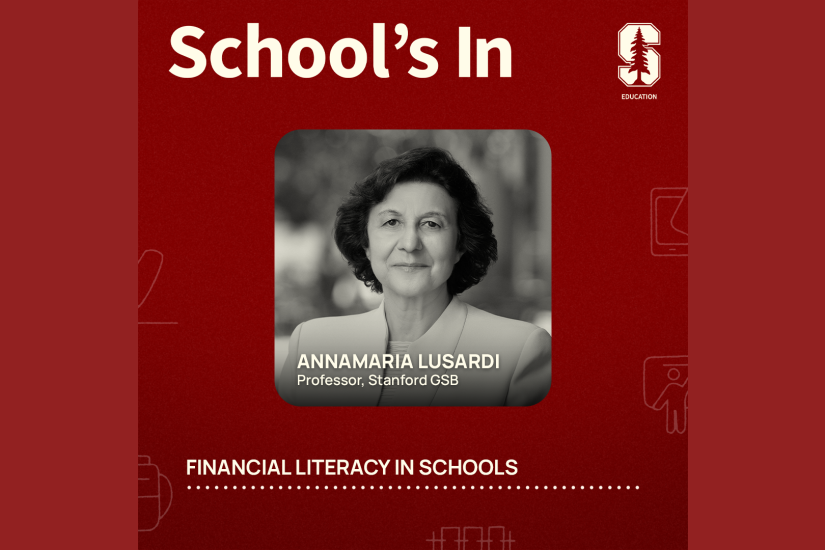
Text messaging program helps boost language skills in preschoolers, study finds
When it comes to spending quality family time together, text messaging doesn’t have to be a villain. It could be an enabler.
Stanford researchers have created a promising new text-messaging program that is designed to support parents in their efforts to teach their children their ABCs and prepare them for kindergarten. The program, called READY4K!, sends weekly cell phone texts to parents of preschoolers to give them bite-sized tips and easy, specific actions related to developing early literacy skills.
“Texting is the medium du jour,” said Benjamin York, a doctoral student at the Stanford Graduate School of Education, who created the texting program with Professor Susanna Loeb. “That could change, but for now, it seems to be the best strategy.”
A successful pilot of the texting program was conducted during the 2013-2014 school year at 31 preschools in the San Francisco Unified School District. The district, which has a robust, ongoing partnership with Stanford to integrate research with real-world practices, has been seeking ways to boost family engagement.
“I believe that all families want to be involved in their child's learning, but many feel they don’t have the time or perceive that supporting their child’s learning might be labor intensive or something that the teacher is better at,” said Meenoo Yashar, Executive Director of Program Quality & Enhancement at SFUSD. “The texting program offered some simple nuggets around literacy strategies and validated that families do want to be involved, if given information that is easy to receive and useful.”
An accompanying study of the pilot, found that the texts, on average, helped increase the frequency with which parents engaged in home literacy activities, such as telling stories, going over words that rhyme, or completing puzzles together. Participating parents also showed higher levels of engagement by asking teachers questions about their children’s growth.
Perhaps most importantly, the increases in parental activity and involvement translated into learning gains for children, York said. The children of parents who participated in the eight-month pilot and received the READY4K! texts scored significantly higher on a literacy assessment than those within a control group of families who received only placebo texts of school-related announcements.
“Our text messages had enough of an effect on the parents that it trickled down to the children, which is really encouraging,” York said. “But it’s not parenting-by-text. The texts are there to just help facilitate authentic parenting.”
Prompting teachable moments
The suggested actions in a text message, for instance, are as simple as “Say two words to your child that start with the same sound, like happy & healthy.” In another set of texts aimed at addressing several literacy skills, parents get tips to make the most of bath time – by pointing out the letters on a shampoo bottle and asking the child to name those letters and the sounds, and then on another day, asking the child vocabulary-building questions to identify body parts and their functions.
“The barrier to some of these positive parenting practices isn’t knowledge or desire, but it’s the crazy, busy lives,” said Loeb, who is the faculty director of Stanford's Center for Education Policy Analysis. “It’s difficult to have the time or focus to make all these choices as parents, and we’re helping parents do what they know they should do and what they want to do.”
The text messages are meant to prompt the teachable moments, eliminating the hassles of decision-making and simply spelling it out for parents, she said.
Parental tips-by-text may seem unconventional, but in today’s world, where texting has become a common communication medium and attention spans have gotten shorter, it’s not far-fetched.
A vast majority of American adults have cell phones; nearly all of them use text messaging; and texting rates are particularly high among Hispanics and blacks, the study cited.
In another sign of the times, an increasing number of health care causes are already using text messages – with proven success – to help people lose weight or quit smoking.
With this growing body of successful texting apps for other complex behavioral changes, York and Loeb set out to develop one for parents.
“To reduce the barriers to good parenting, we immediately thought of texting because it’s so pervasive,” York said. “Surprisingly, no one else was doing this – providing educational content during the preschool year, using this approach.”
However, Loeb added, “we know that changing parental behaviors has proven to be very difficult, so to get these positive effects from our texting program was very exciting.”
Scalable, inexpensive, accessible
York and Loeb worked to break down early literacy standards into educational snippets that would be compelling for parents to carry out in their daily routines without adding burden or costs. The text messages – their sequence and scope, as well their tone – were all carefully crafted to not add stress to parents.
An underlying objective was to make the texting program easily scalable, inexpensive to administer and widely accessible. Indeed, the costs for sending texts for the entire school year were relatively minimal – at $1 spent per participating family – and costs are expected to decrease as the program expands to a larger group of users, York said. School districts can also implement the program in large part by adding a check box on enrollment forms, asking parents if they want to receive texts with educational tips, he said.
“The texting program was experimental, but it made so much sense – it was worth trying,” said Laura Wentworth, Director of the Stanford University/SFUSD Partnership.
Before launching the texting study, Loeb and York had partnered closely with SFUSD on a number of projects related to early literacy. These relationships supported the tight coordination needed to make this texting project happen, and to make the project useful for the district.
The pilot READY4K! program at SFUSD, which was featured in a working paper published Nov. 10 by the National Bureau of Economic Research, has already piqued the interest of other school districts in the nation as well as other literacy organizations, York said.
A total of 440 families participated in the program. Of that group, half of the families were randomly chosen to receive the literacy-based texts, while the other half received placebo texts with district-related announcements.
Three texts were sent each week throughout the school year to the participating parents of four-year-olds. On Mondays, parents received a general fact about the benefits of a certain literacy skill. On Wednesdays, parents got a specific tip on something they could do to work with their child on building that skill. On Fridays, parents received ideas on how they can take it a step further.
The contents of the text messages are based on preschool standards outlined by the California Department of Education. They are also aligned with the curriculum practice of making tasks increasingly more challenging and interspersing reviews of concepts along the way.
In evaluating the pilot program, researchers found that the text messages had a positive impact on the students’ knowledge of both lower-case and upper-case alphabet letters as well as letter sounds. The preschoolers acquired about two- to three-months worth of learning during the pilot program, York said.
The parents who received the texting tips also spent more time doing literacy-related activities with their preschoolers, when compared with parents in the control group, researchers found. This difference was equivalent to about nine to 13 percentile points.
Because of the pilot’s success, the San Francisco school district expanded the program for the current school year to not only all of its preschool families, but also the parents of kindergarteners.
“It would be great to see how we can continue texting as a way to inform families not just about literacy, but about their child's learning in other ways as well,” Yashar said.
In the meantime, Stanford researchers have added early math skills into the weekly texting program and will be looking to gauge its effectiveness.
“Parents really are the first teacher that a student has and are the most important teacher at that (early) age,” Loeb said. “They don’t have to do it the way teachers do it; they just have to work things in with their daily life.”
___
May Wong is a freelance writer who contributes frequently to Stanford Graduate of Education websites and other publications.



